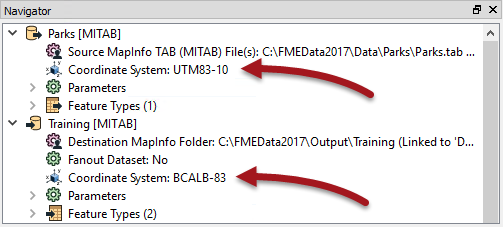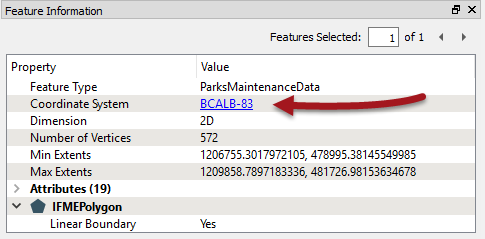| Exercise 6 | Grounds Maintenance Project - Data Reprojection |
| Data | City Parks (MapInfo TAB) |
| Overall Goal | Calculate the size and average size of each park in the city, to use in Grounds Maintenance estimates for grass cutting, hedge trimming, etc. |
| Demonstrates | Data reprojection |
| Start Workspace | C:\FMEData2017\Workspaces\DesktopBasic\Transformation-Ex6-Begin.fmw |
| End Workspace | C:\FMEData2017\Workspaces\DesktopBasic\Transformation-Ex6-Complete.fmw C:\FMEData2017\Workspaces\DesktopBasic\Transformation-Ex6-Complete-Advanced.fmw |
Let's continue your work on the grounds maintenance project.
The parks team has decided that the output data should be in an Albers Equal Area projection (coordinate system = BCALB-83). They think it will take ages to set this up! We'll show them differently...
1) Start Workbench
Start Workbench (if necessary) and open the workspace from Exercise 5. Alternatively you can open C:\FMEData2017\Workspaces\DesktopBasic\Transformation-Ex6-Begin.fmw
2) Edit Reader Coordinate System
On the Navigator locate the Parks [MITAB] reader, and expand its list of settings.
Locate the setting labelled ‘Coordinate System’. The original value should be <not set>:

Double-click the reader Coordinate System setting to open the Edit Parameter dialog.
Enter the coordinate system name UTM83-10 or select it from the Coordinate System Gallery by selecting "More Coordinate Systems..." from the bottom of the drop-down list.

| TIP |
|
Remember, when a reader’s Coordinate System parameter is defined as <not set> FME will automatically try to determine the correct coordinate system from the dataset itself.
When the source dataset is in a format that stores coordinate system information (as it does in this example) you can safely leave the parameter unset. So this step isn’t really necessary. However, you MUST set this parameter when you wish to reproject source data that does not store coordinate system information; otherwise an error will occur in the translation. |
3) Edit Destination Coordinate System
Now locate the coordinate system setting for the destination (writer) dataset.
Again the value should be the default value of <not set>.
Double-click the setting. Enter the coordinate system name BCALB-83 or select it from the Coordinate System Gallery by selecting "More Coordinate Systems..." from the bottom of the drop-down list.

4) Run the Workspace
Save and then run the workspace.
In the log file you should be able to find:
FME Configuration: Source coordinate system for reader MITAB_1[MITAB] set to `UTM83-10' FME Configuration: Destination coordinate system set to `BCALB-83'
5) Inspect the Output
Open the newly reprojected dataset and query a feature. The Feature Information window should report that the data is now in BCALB-83. Optionally, click on the coordinate system name in that window; a new dialog will open to display all of the coordinate system parameters.

| TIP |
| If the background map is activated when a dataset is opened then the contents of that dataset are automatically reprojected to spherical mercator to match the background map. If you wish to see the data as it appears in its own coordinate system, then use Tools > FME Options to turn off background maps before opening the source dataset. |
| Advanced Exercise |
| Instead of using the reader/writer parameters in the Navigator window, why not try this exercise using the Reprojector (or CSMapReprojector) transformer? Where should the transformer be placed in the workspace and why is this important? |
| CONGRATULATIONS |
By completing this exercise you have learned how to:
|